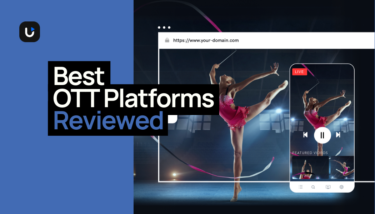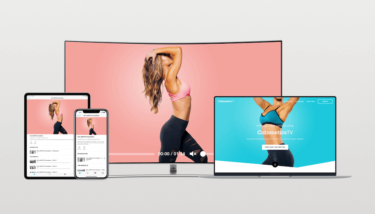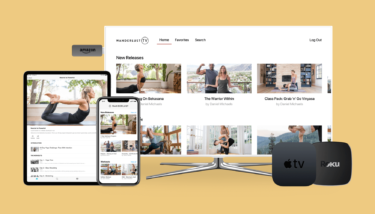🧠 TLDR; Launching OTT apps can supercharge your video streaming business by increasing engagement, retention, and revenue. We studied 2,000+ Customers, creators and brands hosted on Uscreen to help understand the value of OTT apps, here’s a quick rundown:
- Meet your audience where they are: 78% of community activity happens on mobile apps, and TV apps account for 80% of Roku watch time—your viewers expect to watch content on their terms.
- Build daily habits: Push notifications drive 17% more logins, and offline viewing creates routines. When access is effortless, loyalty grows.
- Reduce churn, boost retention: Apps lower monthly churn by 15% and increase watch time by 25%, keeping your members engaged longer.
- Drive higher revenue: Creators with apps sell 1.6x more annual subscriptions, offering a stable, long-term income stream.
- Look professional and trusted: Having an app puts you alongside top streaming platforms, positioning your content as premium and worth paying for.
- Bottom line: Apps aren’t just a bonus—they’re a proven way to grow engagement, revenue, and loyalty.
I love binge-watching my favorites on OTT apps—some days it’s Netflix, other days it’s Disney+. I’m sure you do too. They’re so ingrained in how we consume content, it’s hard to imagine life without them.
As someone who creates and distributes valuable video content, you’ve probably wondered: What if I had my own app? A place for your audience to binge content, connect with your brand, and access everything seamlessly.
But is it worth it?
Between tech setup, app store optimization, and wondering if your audience will use it, it’s easy to hesitate—especially if your video membership is already thriving.
In this guide, we’re sharing everything about OTT apps—how to build them, why even build them at all, and more practical ideas straight from our creators.
What is an OTT App?
I know what OTT apps are, but not sure if it’s worth it
An OTT (Over-the-Top) app is a custom platform that delivers content directly to your audience over the internet, allowing them to access it on their favorite devices—smartphones, tablets, or Smart TVs. OTT apps encompass a broad category of services, including video streaming, audio streaming, messaging, and even gaming, redefining how we connect and consume content across various mediums.
For creators, OTT apps give them the power to deliver seamless, on-demand experiences to their audience—whether they’re streaming during their commute, on their couch with Roku, or on a tablet during a quick workout.
Here’s what an OTT app looks like in the wild: This is Abundance+, a homesteading OTT app from one of our creators, Justin Rhodes.
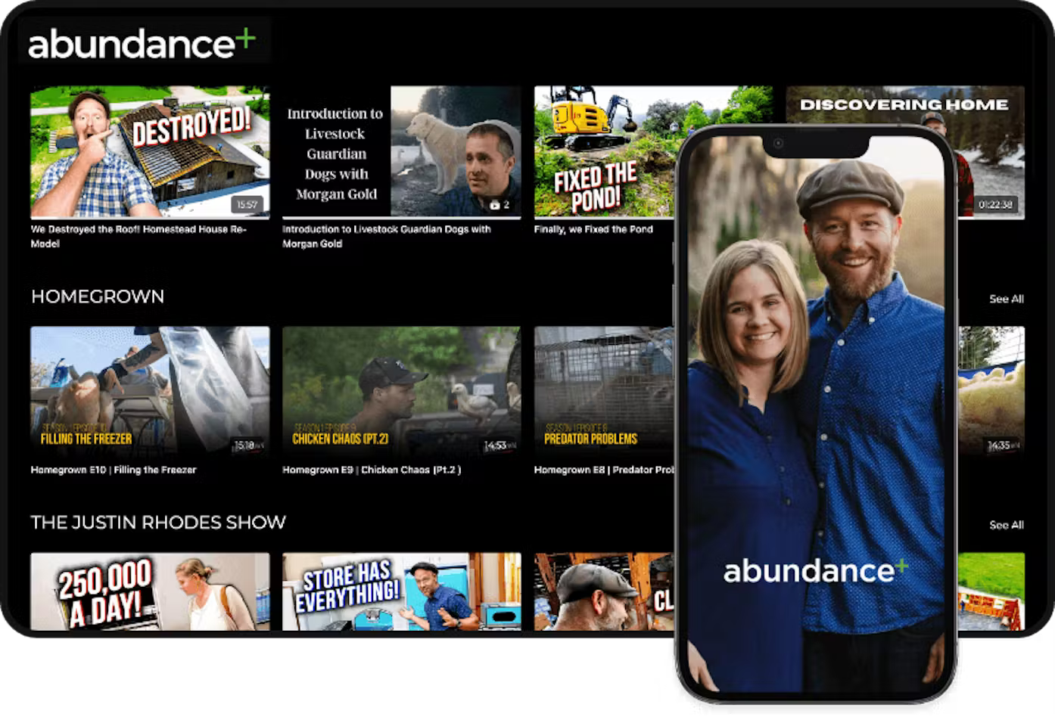
Our data revealed why video creators launch OTT apps (and why viewers love them)
I’m convinced about building OTT apps—take me to the step-by-step guide
If you’re on the fence about launching your own OTT apps, I understand – it’s a big step.
Yet, having a front-row seat myself here at Uscreen, I’ve watched creators move past the “Do I need this?” phase and watch their revenue soar with OTT apps. Working with thousands of video creators and brands has given us some pretty clear insights into what makes a video membership thrive.
Your viewers expect to watch your content on their phones and TVs, not just their computers.
And the numbers back this up.
More people are watching (and paying) through OTT apps
Remember when having a website was considered “optional“?
That’s exactly where we are with OTT apps today.
Our OTT statistics show that consumer spending on subscription-based apps surged last year—35% on iOS and 24% on Android—showing a major shift in how people pay for content.
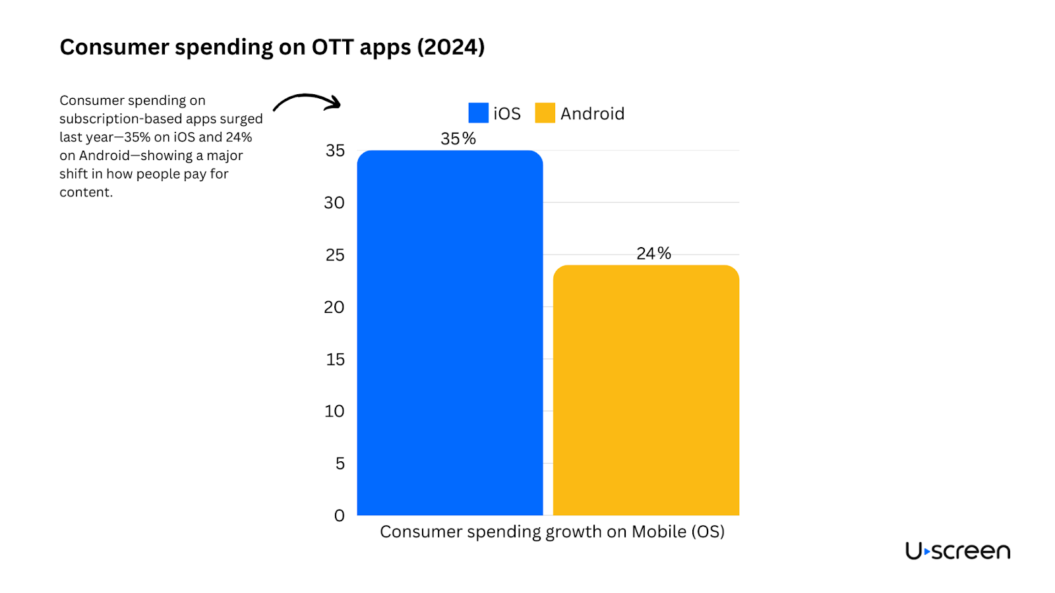
Here’s what we’re seeing at Uscreen: within just 6 months of launching apps, our customers see a 10% increase in user purchases.
Members who use apps have up to 25% more watch time than members who don’t use apps.
And 16% of all paid subscribers come directly through in-app purchases.
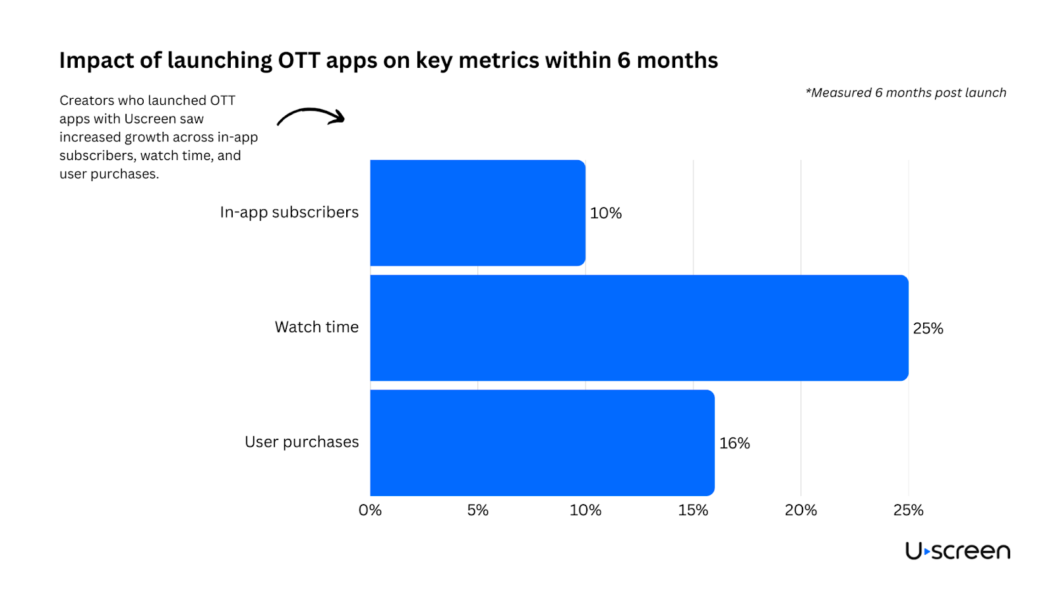
Think of apps as opening new doors to your content house. The more entry points you create, the easier it is for viewers to step in and make themselves comfortable.
Apps gave us an air of legitimacy and got rid of any barriers to accessing the content. We’re available on all the same platforms as the big streaming services, and pose a real alternative option.
Nick Hayes, Founder of Means TV
OTT apps make users more sticky to your platform
Engagement is at the heart of any successful membership, and OTT apps create a level of convenience that can supercharge engagement.
Uscreen customers with apps experience 15% lower monthly churn rates because members with easy access are more likely to stay. Members enjoy these apps, since we see them consistently maintaining a 4.9-star rating on the App Store (yes, you read that right!)
Members are also 17% more likely to log in and spend 25% more time watching—driving deeper engagement and loyalty.
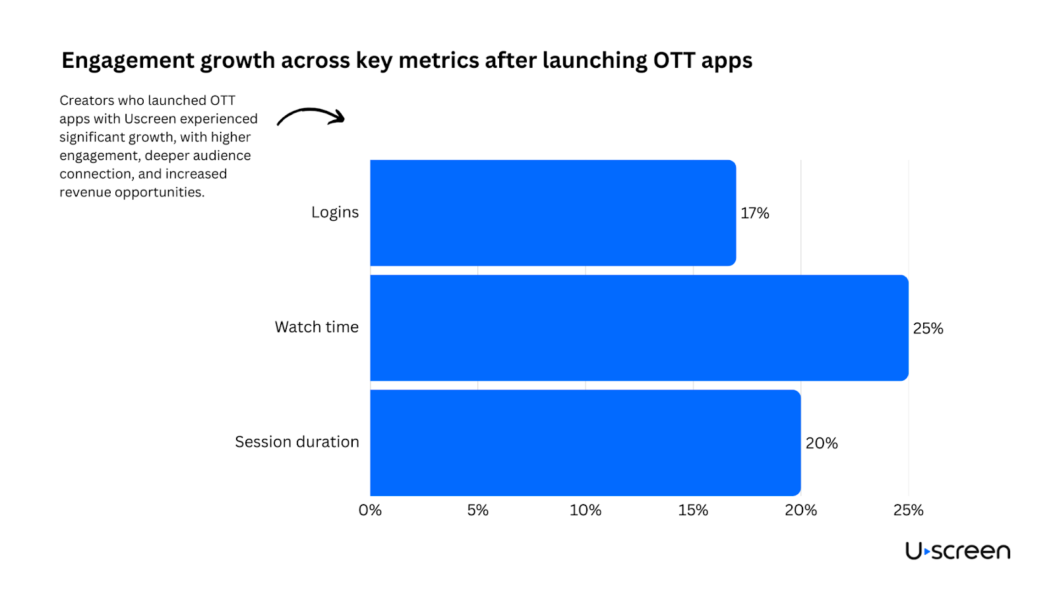
With apps, your members aren’t just consuming content; they’re building habits and routines around your videos.
We always aimed to make things easier for our members, and the app was another way to do that. Members also requested it. One great feature of the app is the ability to work out offline, which is crucial for our global community. People don’t always have reliable Wi-Fi, especially when traveling, and they don’t want to lug a laptop around.
Marnie Alton, Founder of M/Body
You can sell more annual subscriptions and reduce churn
Here’s something that made me do a double-take: creators with apps sell 1.6x higher annual subscriptions than those without.
Let that sink in.
We’re not talking about a small bump – this is a significant multiplier for your business.
Why does this matter?
Because annual subscriptions are like having a sold-out season pass instead of single-show tickets. Your viewers are investing in your entire content journey, not just dropping by for a month.
And here’s the kicker: over 50% of our top 100 GMV earners use our upsell feature to move members from monthly to annual plans. F
or creators, this means less churn, greater revenue stability, and a clear path to sustainable growth.
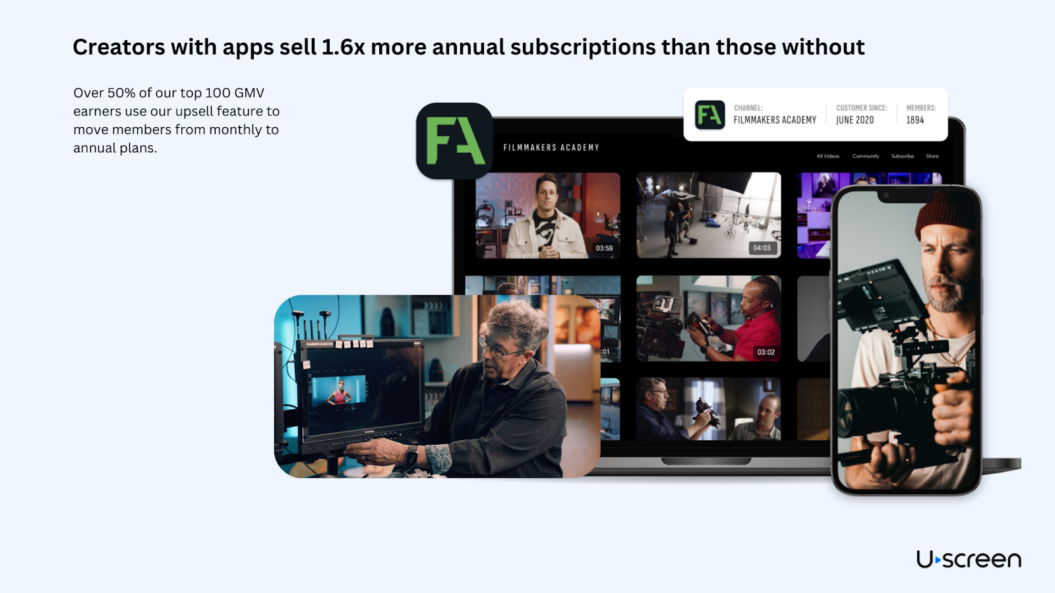
Uscreen executed the app really well. Its interface is great and allows us to showcase that we’re a modern educational company. Launching membership apps was a no-brainer for us as it supports our subscription model and provides access in various formats, not just on the web. Our members love having us in their pocket to reference on set. The ability to ask questions and get help in real-time is invaluable.
Lydia Hurlbut, Co-Founder of Filmmakers Academy
You can retain and entertain your customers better
Uscreen customers with mobile & TV apps see 15% higher retention rates. In the creator economy, that’s like finding gold.
Better yet, members who use apps spend 25% more time watching your content.
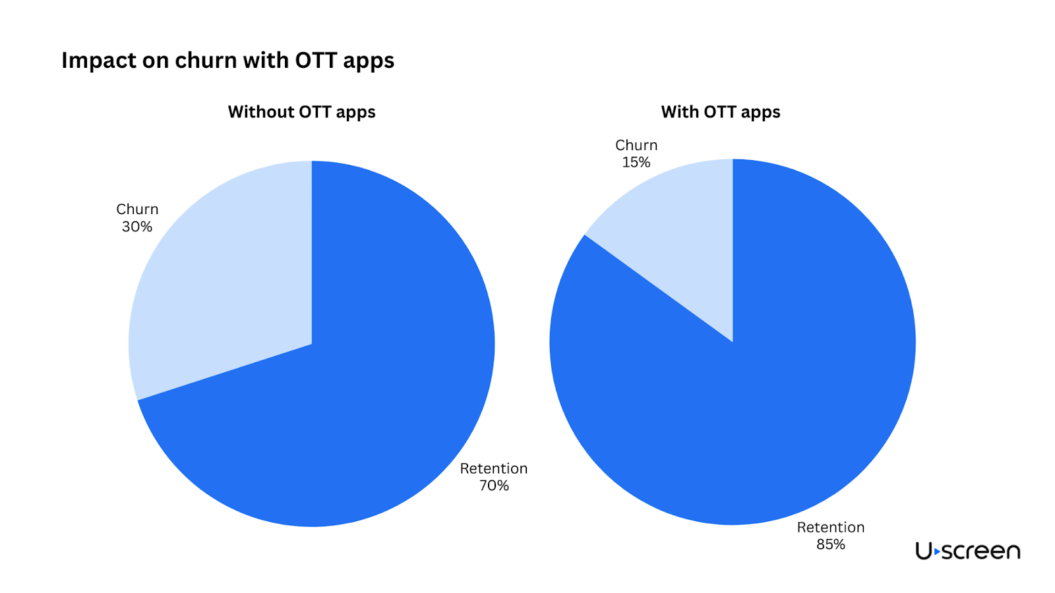
And with 78% of community activity happening on mobile apps, they’re important for fostering engagement and reducing churn.
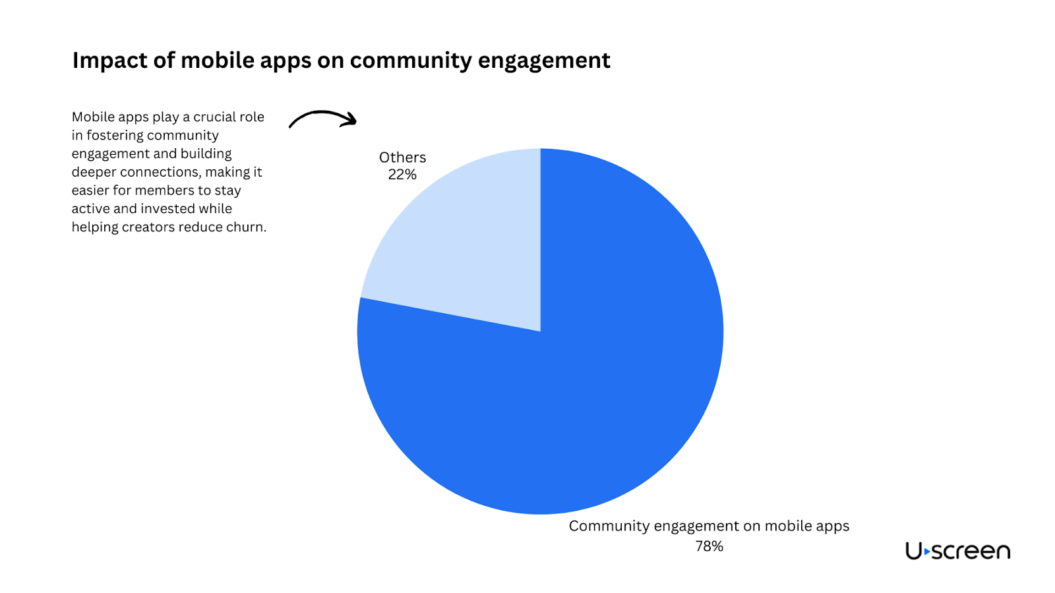
With Uscreen, I love using the app. It’s easy to navigate, and I always see new notifications and interactions from members. I check the community several times a day and personally answer questions, making sure I’m not missing anything my members need.
Macy Pruett, Founder of Fittest Core
How to launch your OTT App: A step-by-step guide
Launching an OTT app is a big task, but you can make it easier by breaking it into simple steps. For a quick overview, you can watch this video by Daniel Kosmala, senior marketing manager and creator at Uscreen.
For an in-depth process, continue reading this blog:
Step 1: Set the right goals: aim for conversion over traffic
Start by setting a clear conversion goal for your OTT app. While aiming for recognition—like hitting the top of trending charts—is exciting, the real drivers of growth are your business KPIs: app downloads, subscriber sign-ups, and trial-to-paid conversions. Focus on the metrics that directly impact your revenue and audience engagement. Use a simple framework to define and prioritize the metrics you’ll optimize for as you launch.
| Stage | Metric | Goal | Action Plan |
| Awareness | App downloads | 1,000 downloads in the first 30 days | Run targeted ad campaigns and leverage social media |
| Website visits | 5,000 visitors during the launch month | Optimize SEO and launch promotional emails | |
| Engagement | Weekly watch time | 100+ minutes/user in the first month | Promote high-value content and use push notifications |
| Trial activations | 500 trials in the first 30 days | Offer a limited-time free trial incentive | |
| Conversion | Trial-to-paid conversion | 20% conversion within the first 3 months | Use email nurturing and exclusive onboarding content |
| Revenue per user | $50 average in the first quarter | Offer upsells like annual plans or premium bundles |
Step 2: Lay the groundwork of your OTT business model
Your business model isn’t just a box to check—it’s the blueprint for how you’ll make money and keep your audience happy. The important things is it needs to align with your content and audience preferences to create the best possible impact. Here’s how to lay a solid foundation:
| Action | What to do |
| Pick your revenue model | Choose from SVOD, TVOD, AVOD, or HVOD. Tip: If you’re starting out, SVOD is the simplest and most reliable for recurring revenue. |
| Do a quick audience survey | Ask your audience what they’d pay for and how they prefer to watch content. This feedback is pure gold. |
| Test the waters with bundles | Start small by bundling a few videos or courses to see what sticks before committing to a full-fledged model. |
| Map out your pricing tiers | Create monthly and annual options. Pro tip: Annual plans = 1.6x more revenue. |
| Set a launch goal | Example: Convert 10% of free trial users into paying subscribers within 3 months. |
The trickiest part of this step is deciding how you’ll make money. Choosing the right revenue model can feel overwhelming, so here’s a closer look to help you decide:
Here are your top options to consider:
- SVOD (Subscription Video on Demand):
This is the classic “Netflix-style” model where subscribers pay a recurring monthly or annual fee for unlimited access to your content. It’s perfect for creators who release regular content and want to build a predictable income stream. Bonus: SVOD fosters community by encouraging investment in subscriptions. Our data shows SVOD apps boost retention by 15% and drive 78% of community engagement on mobile.
- TVOD (Transactional Video on Demand)
Think of this as pay-per-view. Users pay for individual videos or events—great for one-off workshops, live streams, or premium standalone content. TVOD works well if your audience prefers to buy specific pieces rather than commit to a subscription. Consider this model if:
- You’re producing high-value, standalone content
- You host live events or workshops
- You want to offer premium content alongside a subscription
- You’re just starting and want to test different price points
Our data shows that up to 50% of live streams are watched from apps, making TVOD particularly effective for special events.
- AVOD (Advertising Video on Demand)
Your content is free to watch but supported by ads. This model is ideal if you have a large, engaged audience and want to maximize your reach before directly monetizing. It’s also a good way to appeal to viewers who aren’t ready to pay upfront. Consider this if:
- You have a large, engaged audience
- Your content appeals to specific advertisers
- You want to maximize reach before monetizing
- HVOD (Hybrid Video on Demand)
A mix of free and paid content. For example, offer some videos for free (supported by ads) while locking premium content behind a subscription. HVOD is great for balancing audience growth and revenue generation, giving you the best of both worlds.
🧠 TLDR; If you’re new to OTT, SVOD might be the most straightforward and lucrative way to start building recurring revenue, since subscribers pay monthly for unlimited access. TVOD (pay-per-view) could be appealing for those offering exclusive, high-value content, especially for events or special content drops. Finally, HVOD combines free and paid content options, helping attract a broader audience while monetizing premium features.
The model you choose affects everything from pricing to content access.
Explore more on OTT business models.
Step 3: Understand your options for building an OTT app
Deciding how to build your OTT app is more than just picking a platform—it’s about setting the stage for how your audience experiences your content, how you monetize it, and how smoothly you can scale. This decision affects everything from your app’s design and functionality to the time and resources you’ll invest.
Whether you’re looking for full control, a quick setup, or a balance between ease and flexibility, understanding your options is key to building an app that fits your goals and grows with your business.
There are mainly two ways you can build an OTT app:
| Option | Best for | Pros | Cons |
| DIY i.e hire an agency or team of developers | Brands that have very specific requirements in terms of features and back-end infrastructure with larger budgets and timelines (6-12 months) | Full customization, control over features | High costs, long timelines, requires expertise |
| No-code OTT platforms like Uscreen | Creators and brands looking for reliable, easy, and fast OTT app development | Turnkey solution, scalable, great support, quick to launch, budget-friendly | Monthly fees or revenue share |
The choice between building your OTT app from scratch or using a no-code platform depends on your resources and priorities. If you’re inclined towards no-code OTT platforms like Uscreen, you need to consider the following features:
Now, before we get into the nitty-gritty, here’s an important disclaimer:
Always check a platform’s migratability and commitment level before signing up. Just because they don’t require a contract doesn’t mean it’s easy to move if you change your mind later.
At Uscreen, we’ve migrated over 1,000 businesses and have seen firsthand how challenging some platforms make it to switch. So, if you’re considering migrating, make sure to ask the right questions upfront.
Here’s what migrating to Uscreen looks like.
Now that we’ve got that out of the way, let’s take a closer look at the must-have features your OTT app builder should have:
- Intuitive user interface: A platform that’s easy to use (and love)
First impressions matter, and the interface is the first thing your audience will notice. It should be intuitive—so easy to navigate that even the least tech-savvy viewer can easily find what they’re looking for.
Think simple navigation, clear menus, and zero frustration. Beyond usability, look for customization options.
Your OTT platform should feel like your brand. That means logos, colors, themes—whatever it takes to make it uniquely yours.
Consistency builds trust, and trust keeps people coming back.
For us, the more turnkey and simple the system, the better, because it means less management on our end. None of us are custom coders—we’re all filmmakers. We didn’t go to school for web design or anything like that. So, it’s great that with just a basic understanding of Uscreen’s backend, anyone on our team can facilitate changes and update things in real-time.
Brendan Sweeney, CEO of Filmmakers Academy
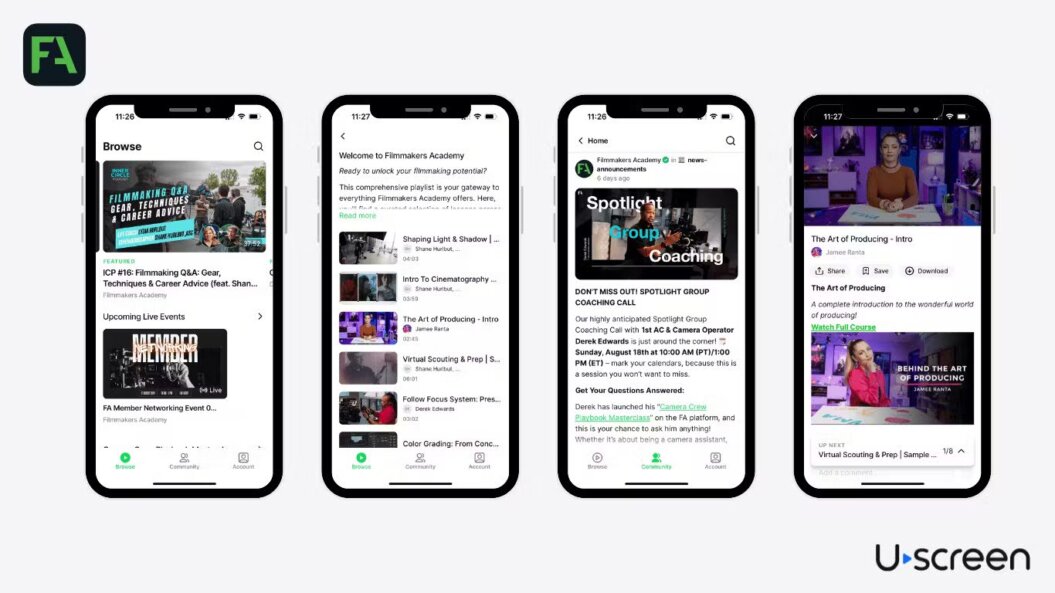
- Multi-device support: Lets you reach where your audience watches content
Your audience isn’t just on one device anymore—they’re everywhere. Phones, tablets, laptops, smart TVs—you need a platform that’s as flexible as your viewers.
Make sure it works seamlessly across web browsers, iOS, Android, and smart TVs, with a responsive design that adapts beautifully to any screen size. Because if your content looks great on their 70-inch TV and their phone, you’re golden.
Our team was intrigued and wanted to know just how much of an impact multi-device support really mattered.
Here’s what we found:
For mobile apps (iOS and Android):
- 6% of paid subscribers come from in-app purchases,
- 78% of community engagement happens on mobile,
- watch time increases by 25% compared to web-only viewing,
- push notifications drive 17% more logins.
On TV apps (Roku, Apple TV, Fire TV, Samsung TV):
- Roku dominates with 80% of all watch time,
- nearly 50% of viewers watch content exclusively on TV apps,
- Faith & Spirituality apps lead with over 50% of watch time, followed by Media & Entertainment apps at 30%.
Having the mobile app to be fully functional on iPhone and Android within a short amount of time was huge for us. Your turnaround time was excellent. You guys kept on updating us and in the past we had issues where apps would get broken with updates and basically, too many glitches.
Navin Ramharak, Co-founder, In the Lab
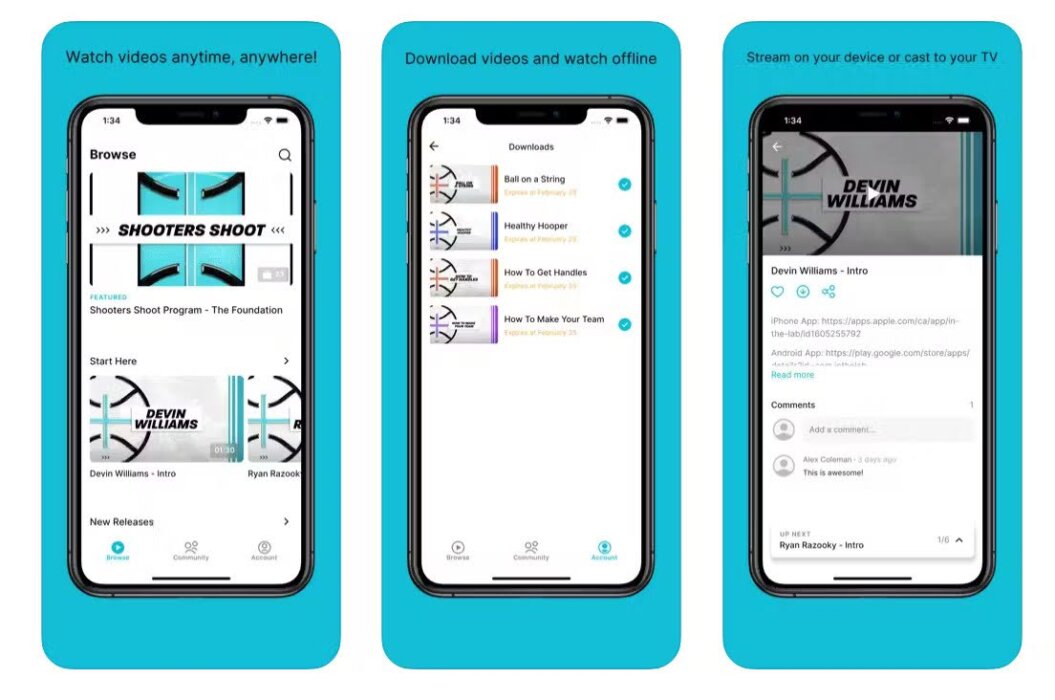
- Monetization options: Gives you multiple ways to monetize your OTT apps (options)
When it comes to OTT monetization, flexibility is key. Whether you’re offering subscriptions, pay-per-view rentals, bundled packages, or even gift cards, your platform should make it easy for you to experiment and find what works best.
Bonus points if it includes promotional tools like free trials or discount codes—because everyone loves a good deal, and they’re great for pulling in new subscribers.
We’re able to have different prices which wasn’t allowed to us as customers with our previous platforms.
Navin Ramharak, Co-founder, In the Lab
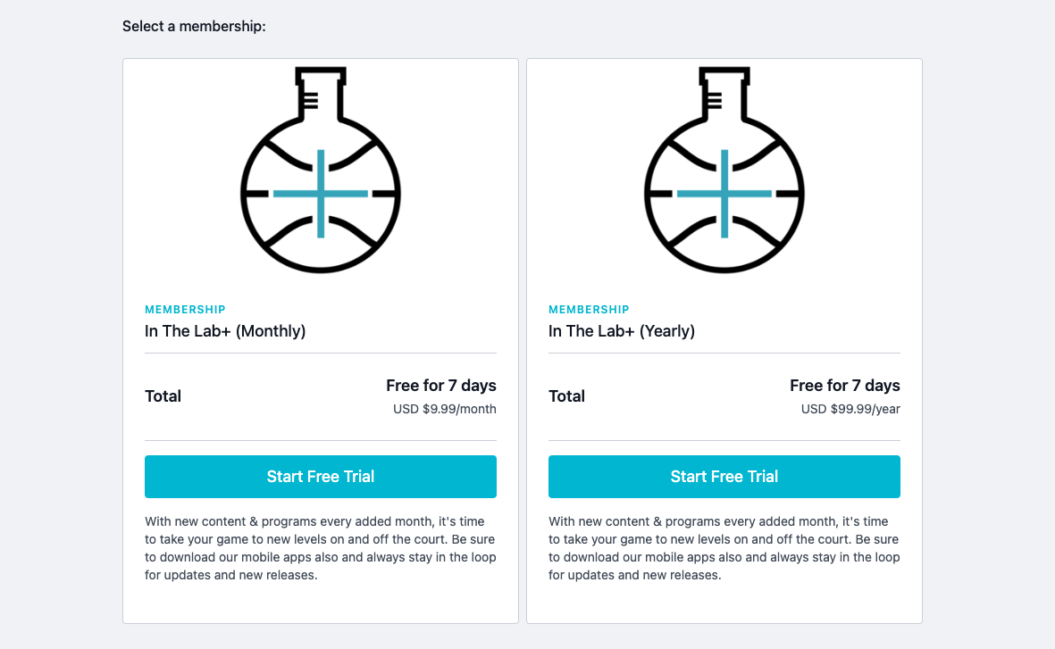
- Content management: Makes content management a breeze
Uploading and organizing content should be straightforward. Bulk uploads save time when you’re adding a lot of videos, and organization tools like playlists and categories help you structure your library in a way that makes sense for your viewers.
Here’s an in-depth guide on how to categorize your VOD content for higher engagement
When members type in the search bar, they see a gallery of beautiful thumbnails, making it quick to find what they need.
Liz Kohler Brown, Founder of The Studio Membership
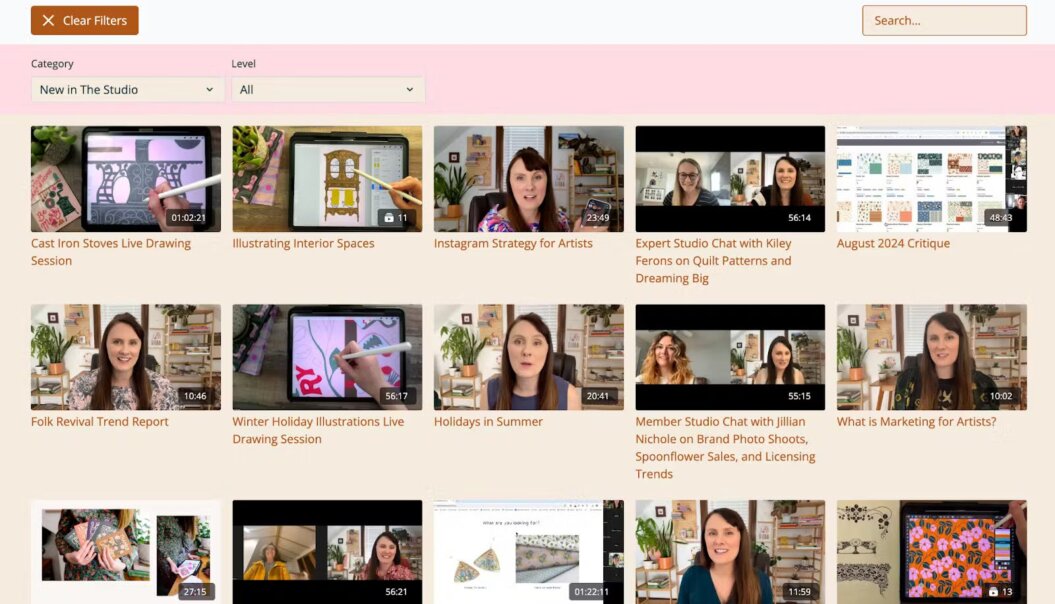
- Data privacy: Keeps your content (and payments) safe
Your content is your hard work—it deserves to be protected.
A solid OTT platform will have digital rights management (DRM) to prevent piracy and unauthorized sharing.
And let’s not forget payment security. Your platform should comply with PCI standards to ensure that every transaction is as safe as it gets.
- Streaming performance: Offers seamless streaming without the buffering drama
There’s nothing worse than buffering. To avoid this, your platform should offer adaptive bitrate streaming, which adjusts video quality based on internet speed to keep playback smooth.
And if you’ve got a global audience?
A content delivery network (CDN) ensures your videos stream reliably, no matter where your viewers are.
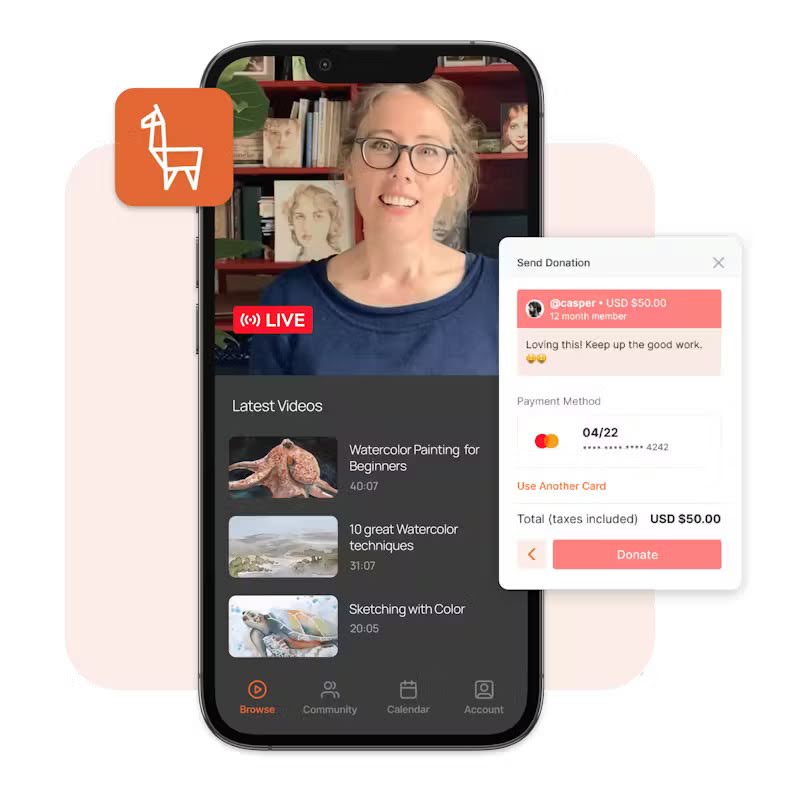
- Strong analytics: Lets you measure your OTT app’s performance
You can’t grow what you don’t measure, so analytics are a must. You need insights into how viewers interact with your content—what they’re watching, how long they stay, and when they leave.
Add revenue reports into the mix, and you’ve got a complete picture of what’s working and where to tweak.
Uscreen is very focused on analytics, which is super important to me. I can easily see what people are watching based on collections or individual videos.
Liz Kohler Brown, Founder of The Studio Membership
Here’s a peek into what Uscreen’s analytics look like:
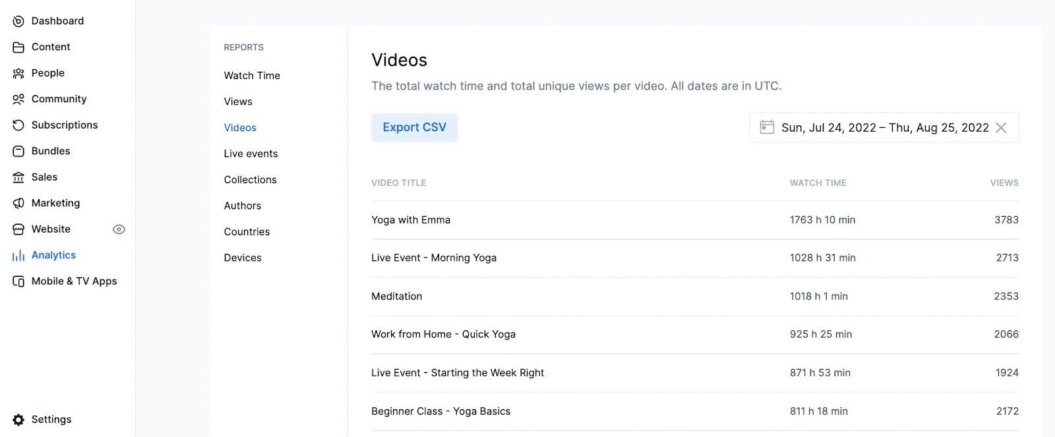
- Engagement and retention tools: Helps you keep the conversation going
A great OTT platform doesn’t just deliver content; it helps you engage your audience.
Features like email marketing integrations and in-app notifications are perfect for sending updates, promotions, or just nudging viewers to check out your latest release.
The more connected your audience feels, the more likely they are to stick around.
What I love most about Uscreen is the comprehensive backend feature set. It’s like playing an instrument—I manage push notifications, email broadcasts, upselling functions, and abandoned cart features all within the Uscreen platform. I no longer have to rely on a bunch of different plugins or sites to get things done…whether it’s our marketing team, editorial team, or operations—we can all access and manage the membership seamlessly.
Brendan Sweeney, CEO of Filmmakers Academy
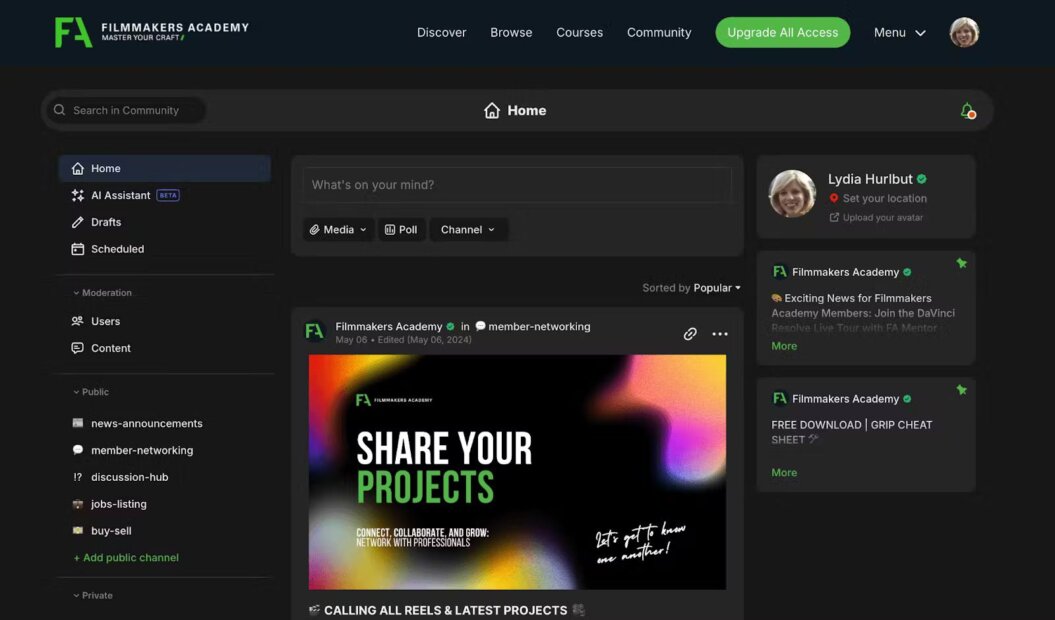
- High scalability: Gives you room for growth
Your OTT platform isn’t just for today; it’s for where you’re headed. As your content library and subscriber base grow, the platform should scale with you—no hiccups, no lag.
Look for features like API access for custom integrations and advanced functionality that can evolve alongside your business.
Uscreen is so on it in development and scaling evolution, like in an evolution for your clients. Ultimately for our members, sometimes we get the feedback and I don’t even have to tell you guys to think about it before you’re already doing it. That’s a big one.
Brooke Cates, CEO and Founder, The Bloom Method
- Great customer support: Offers a team that’s got your back
No matter how intuitive a platform is, there will be moments when you need help. That’s why responsive customer support is non-negotiable.
Whether it’s tech troubleshooting or learning how to use a new feature, having a support team (and access to tutorials or webinars) makes all the difference.
What I really love the most is the support. So if I have an issue or a customer emails us, I forward it to your guys’ support email and I swear to God you guys answer in like 20 minutes, like every time. And that’s helpful for me because I copy and paste the response back to the customer. But we’ve never had that before. Normally, it’s like the iPhone app is broken and we’re wondering “where do we start?” because we didn’t build the app, we don’t know how to solve it.
Navin Ramharak, Co-founder, In the Lab

Choosing an OTT platform isn’t just about the features; it’s about alignment. It should match your goals and meet your audience’s needs.
Take advantage of demos or trials to test the waters and see how a platform feels in action.
The right OTT platform is more than just software—it’s an investment in your brand’s future. Choose one that helps you shine and keeps your audience coming back for more.
🧠 TLDR; Look for a platform that’s user-friendly, works across devices, offers flexible monetization, and protects your content. Prioritize features like high-quality streaming, robust analytics, and strong customer support to keep your audience engaged and your business growing. Check out the OTT platform comparison for more insights.
Step 4: Pricing your app for success
The way you price access to your content doesn’t just impact how much you’ll take home—it’ll also impact how your audience perceives the value you bring.
Set it too high, and you risk scaring people away.
Set it too low, and you’re sending the message that your content isn’t worth much.
And believe me, underpricing is one of the most common mistakes creators make.
We’ve seen this happen often: creators set their prices low to attract more members, only to find that it leads to higher churn, lower revenue, and audiences who don’t take their membership seriously.
Our senior marketing manager and creator, Daniel Kosmala, actually broke this down in a video, sharing real data and examples to show why underpricing can hurt your membership more than it helps.
He explains how pricing impacts audience perception, churn, and revenue, and how to avoid the pitfalls of setting your value too low.
Check out Daniel’s video here for a deeper dive into the numbers and insights behind pricing your membership for success.
The key is to find that sweet spot where your pricing reflects your value and attracts the kind of members who’ll get the most out of what you offer. And don’t worry, we’ve got data-backed strategies to help you nail it.
Our internal data reveals that membership business owners in the education sector charge the highest fees, followed by those in the entertainment, faith, and fitness sectors.
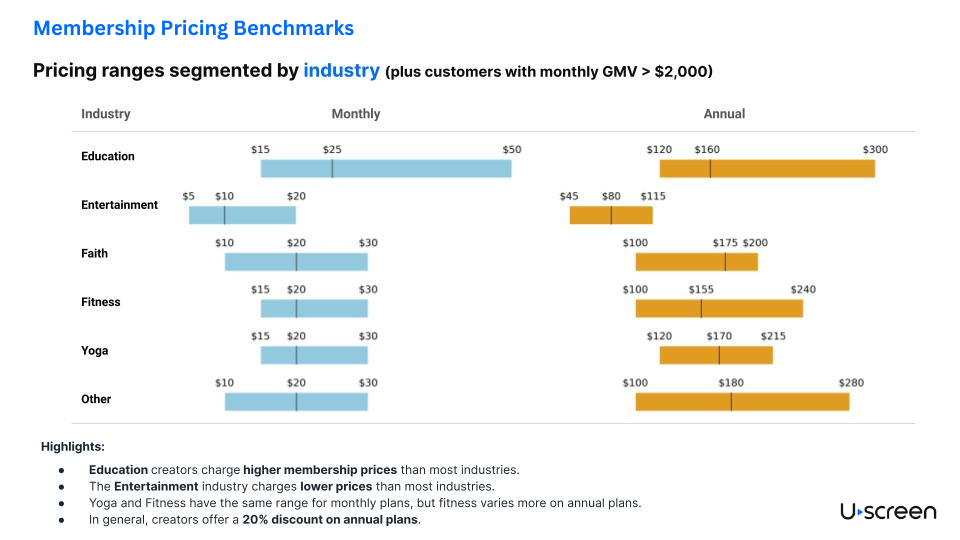
In the education sector, monthly membership fees range from $15 to $25, with annual fees spanning $120 to $300. This pricing likely reflects the specialized knowledge provided and the significant impact these services have on members’ lives.
Conversely, in the fitness industry, monthly fees also range from $15 to $30, but annual fees vary more widely, from $100 to $240. This variation can be attributed to the diverse array of services offered, such as personal training, group classes, or access to specialized equipment.
From our comprehensive data analysis, a few effective strategies emerge clear:
- Offer multiple tiers: Monthly and annual plans are key. Annual plans bring in 1.6x more revenue, and they foster greater loyalty among your audience. You can also include quarterly options for added flexibility.
- Leverage free trials: A 7–14 day trial is often the sweet spot for conversions. Within six months of launching apps, creators see a 10% increase in purchases, driven in part by effective trial offers.
- Upsell to annual plans: Over 50% of top-performing creators use upsell features, with 90% of those upsells moving members from monthly to annual subscriptions.
🧠 TLDR; If you’re still unsure about how to price, remember this: higher prices often mean lower churn and more committed members. When people pay more, they perceive more value—and they stick around longer.
Need help with pricing? Check out our membership pricing calculator to find an initial pricing plan.
Step 5: Create a video website that supports your app
A high-quality video website complements an OTT app. This website should be more than a gateway to the app.
It’s where new members learn about your value, and where you can drive sales through engaging content previews, subscription offers, and user testimonials.
Here’s a quick summary of key elements to include:
Clear value proposition above the fold
- Lead with your strongest benefit (e.g., “Access expert fitness training anywhere, anytime”)
- Include a compelling hero video or image showcasing your content quality
- Make your CTA prominent and action-oriented (“Start Your Fitness Journey” vs. just “Sign Up”)
- Highlight cross-platform availability with device icons (mobile, TV, web)
Content previews that work on all devices
- Feature short, high-quality video snippets (30-60 seconds)
- Ensure previews load quickly and play smoothly on mobile
- Include a mix of content types to showcase variety
- Add preview thumbnails that capture attention
- Consider creating a special “app preview” video showing the mobile experience
Social proof
- Display that 4.9 App Store rating prominently
- Feature user testimonials with profile pictures and real names
- Include success stories from your community
- Show total watch hours or member count if impressive
- Display logos of any media coverage or partnerships
- Highlight awards or recognition your content has received
Easy navigation to subscription options
- Keep pricing plans visible and easy to compare
- Include FAQs addressing common subscription questions
- Make the sign-up process 3 steps or fewer
- Display payment security badges
- Offer multiple payment options
- Include a money-back guarantee if you offer one
Website must-haves for app success
- Mobile-responsive design (crucial since most users will check your site on phones)
- Fast loading times (aim for under 3 seconds)
- Clear app download links/buttons
- Screenshot gallery of the app interface
- Live chat or quick support access
- Blog or content hub showcasing your expertise
- Easy account management access
- Clear links to your privacy policy and terms
Technical optimization tips
- Implement proper SEO metadata
- Use structured data for rich snippets
- Optimize images and videos for fast-loading
- Set up proper tracking (Google Analytics, conversion tracking)
- Ensure cross-browser compatibility
- Implement SSL security
- Set up proper redirects from old URLs if updating
Community showcase section
- Feature member spotlights
- Display user-generated content
- Show activity feeds or recent engagement
- Highlight community milestones
- Display real-time member count or activity stats
🧠 TLDR; Your website should tell your brand’s story and make the value of your app immediately clear. At Uscreen, we’ve found that websites that clearly showcase the app experience alongside web features see higher conversion rates to paid subscriptions.
Step 6: Launch and Promote Your App
Nobody stumbles into a successful app launch. It’s all about strategy, sweat, and smart execution.
The good news?
With the right approach, your app can drive higher engagement, better retention, and increased revenue.
This timeline outlines three phases for launching and promoting OTT apps: Pre-launch focuses on building anticipation and optimizing visibility, while the Launch window drives engagement through promotions, notifications, and reviews. The Post-launch phase prioritizes deepening engagement, improving retention, and expanding outreach to sustain growth.
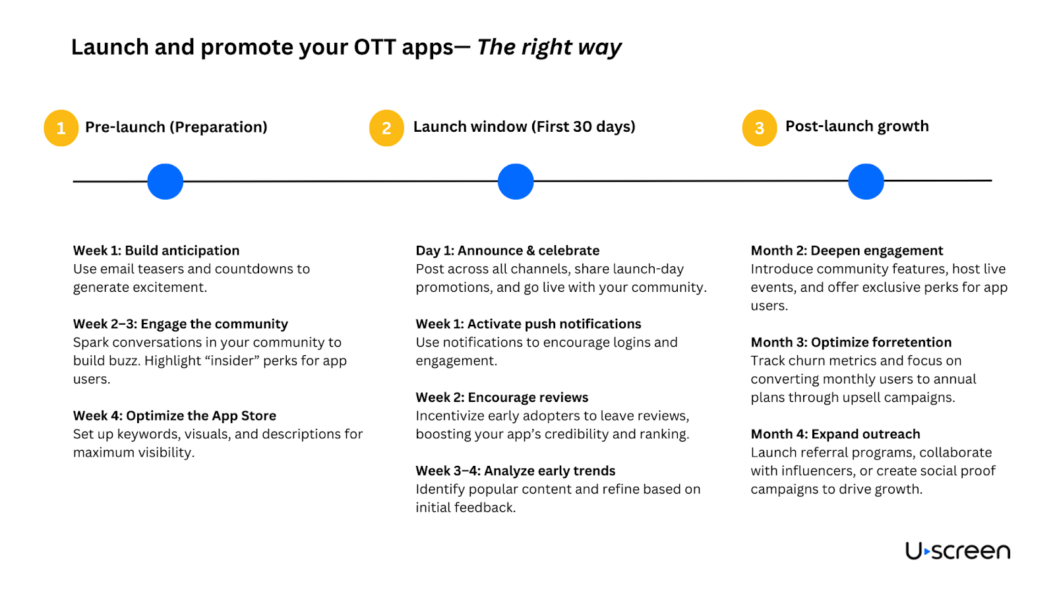
Success metrics to track
Knowing your numbers is non-negotiable if you want to grow. But instead of getting bogged down in endless stats, let’s focus on the metrics that truly move the needle.
Watch Time & Engagement: How glued are they to your content?
- Total weekly watch time: Aim for 100+ minutes per user—more time spent = deeper loyalty.
- Average view duration: Target 17 minutes per session to ensure users stay engaged.
- Login frequency: Apps see 17% more logins, thanks to easy accessibility and push notifications.
- Community activity: With 78% of activity happening on mobile, an engaged community means less churn and happier members.
Subscriber Metrics: Are they sticking around (and paying more)?
- Churn rate: Apps reduce churn by 15%, giving you steadier revenue streams.
- Annual plan upgrades: Customers with apps sell 1.6x more annual subscriptions—a must-track for long-term revenue.
- Free trial conversion: How many trial users turn into paid members? A 7–14 day trial is your sweet spot for higher conversions.
Technical Performance: How smooth is their experience?
- Crash-free streaming: Lagging or buffering? Fix it fast. App users don’t forgive tech hiccups.
- Load times: Fast and seamless keeps users coming back.
Growth Metrics: Is your app delivering ROI?
- Customer acquisition cost (CAC): Keep an eye on how much it costs to win a new subscriber.
- Revenue per user: Apps deliver 16% of paid subscriptions directly—track how much they’re contributing.
- Marketing effectiveness: Which campaigns, channels, and promotions are driving the most app installs and subscriptions?
Use these metrics to double down on content that drives watch time and retention. Fine-tune your pricing strategy for maximum upgrades to annual plans and optimize app performance to give your audience the Netflix-level experience they expect. Also, invest in marketing channels that lower CAC and boost ROI.
Get our step-by-step OTT App Launch Playbook and learn how to go from concept to launch with confidence. 🚀 Packed with actionable tips, expert strategies, and must-have checklists, this guide will help you:
✨ Streamline your launch plan
✨ Set up your app for success
✨ Attract and retain subscribers
Whether you’re just starting or scaling up, this playbook is your roadmap to OTT success.
Download it now and turn your vision into a thriving app! 📥
🧠 TLDR; A successful app launch starts with smart planning. Build excitement pre-launch with teasers and App Store optimization. During launch, focus on push notifications (+17% logins) and gathering reviews. Post-launch, track key metrics like weekly watch time (100+ minutes) and annual upgrades (1.6x higher with apps). Engage your mobile community (78% activity happens here) and ensure a seamless experience to drive loyalty and revenue.
For more tips, check out our OTT marketing guide.
Top 5 platforms to build your OTT apps
Uscreen
Best for: Creators building premium streaming apps with built-in community access
G2 rating: ⭐️4.8 out of 5
Apps included
Pros:
- All-in-one platform: Uscreen provides everything you need to run your video membership business. Aside from apps, you’ll have a web builder, in-built marketing & analytics tools, access to support, and features like community and live streaming. Plus, built-in integrations for your existing tools.
- Premium, professional quality apps: Our app specialists create your apps for you; all you need to do is request them. In return, you’ll get a professional-quality streaming app that is maintained by the team, ensuring your users always have the best experience.
- Netflix-style experience: Offer your audience a familiar and user-friendly interface with on-demand access to your content, customizable playlists, and categories.
Cons:
- Requires engaged fanbase: To really get the most out of Uscreen, you’ll need an established audience ready to sign up for paid content and a membership experience.
- Membership-focused platform: Uscreen is a platform built for creators who are serious about building a video membership business, and may not be suitable for beginners.
- Limited customization: Our apps are built using an out-of-the-box solution. If you want something bespoke with custom features, this might be too limiting.
Pricing
The App Essentials plan starts from $499 per month.
Vimeo OTT (Vimeo Streaming)
Best for: Filmmakers focused on high-quality delivery
Apps included
Pros:
- High-quality video streaming: Vimeo OTT (Vimeo Streaming) is known for its high-quality video streaming, providing a reliable experience to your subscribers.
- Analytics: You’ll be able to see how subscribers are interacting with your content.
- Marketing tools: Vimeo OTT’s marketing tools make it easy to promote your app and attract new subscribers.
Cons:
- Limited customization: Users have reported that Vimeo OTT (Vimeo Streaming) offers limited customization for video players and templates.
- Customer support challenges: Many users have experienced difficulties with customer support, like delayed responses and generic answers.
- Potential for increased costs: As your subscriber base grows, the cumulative per-subscriber fees can become expensive.
I had a couple of conversations with Vimeo, and Vimeo was obscenely expensive, plus they do revenue sharing and take a percentage of your income. I also found that their stuff was a little bit clunky and slow to load.
Matt Allen, Founders of Adjusters TV (read the full story of how they grew their revenue by 407% after moving to Uscreen)
Pricing
Vimeo Streaming apps are available with custom pricing plans, meaning you’ll need to contact them directly for a quote.
See how Vimeo Streaming stacks up against Uscreen

Muvi
Best for: Enterprises and broadcasters
Apps included
Pros:
- No-code solution: You can easily create your own branded OTT website and apps without any coding. If you are a creator wanting a quick and easy launch, Muvi simplifies the process.
- Simple content management: Muvi provides a straightforward system to upload, organize, and manage your video library.
- Flexible monetization options: You can choose how you make money – subscriptions, pay-per-view, ads, or even merchandise sales with Muvi Kart.
Cons:
- Limited website template customization: Muvi’s website templates offer limited customization for your video catalog page.
- Limited marketing tools: Muvi’s marketing features and integration options are somewhat limited. You might need to rely on external tools to implement your full marketing strategy.
- Confusing CMS workflow: Some users find Muvi’s content management system workflow confusing and requires a learning curve.
Pricing
Standard: $399 per month + $299 per month per app. Fully featured while labelled website/app, hosting and CDN.
Professional: $1499 per month + $499 per month per app. Alie recommendation engine, DRM, Content partner portal, & policy engine.
Enterprise: $3900 per month + $499 per month per app. Dedicated server and enterprise support
Ultimate: Custom pricing. Unlimited concurrent users, monthly security and performance reports, proactive monitoring, setup, and increased support.
See how Muvi stacks up against Uscreen

Brightcove
Best for: Large organizations needing custom app solutions
Apps included
Pros:
- Advanced analytics and security: Brightcove provides powerful features, including in-depth analytics to understand your audience and strong security measures to protect your content.
- Scalability for large-scale video operations: Brightcove is built to handle large-scale video businesses and high volumes of traffic.
- Reliable global content delivery: Brightcove uses a top-tier CDN to ensure fast, high-quality video streaming everywhere. This means a reliable and consistent viewing experience for a global audience.
Cons:
- High cost: Brightcove is priced as an enterprise solution, making it less accessible for independent creators or small businesses that need an affordable OTT solution.
- Resource-heavy: While Brightcove offers flexibility, full customization often requires a development team and additional budget, making it challenging for non-enterprise users.
- Steep learning curve: The platform’s extensive feature set can be overwhelming, especially for those unfamiliar with video hosting and OTT service management.
Pricing
Contact Brightcove directly for advice on OTT app pricing.
Zype
Best for: Businesses and creators looking for flexible API to shape their customization
Pros:
- Comprehensive video management: Zype offers an all-in-one solution for storing, managing, monetizing, and delivering both live and on-demand video content across various digital devices.
- API-first approach: Zype’s robust API allows for extensive customization and integration with existing systems, providing flexibility for developers.
- Monetization flexibility: Zype supports various monetization strategies, including subscriptions, advertising, and pay-per-view, enabling you to choose the best model for your business.
Cons:
- High Cost: Starting at $500 per month, Zype may be cost-prohibitive for smaller creators or businesses with limited budgets.
- Technical Complexity: The platform’s extensive features and API-first approach may require significant technical expertise to implement and manage effectively. Users have reported that some aspects of the admin interface can take time to learn.
- No Built-In Video Hosting: Zype does not provide native video hosting services, requiring users to integrate with external hosting providers, which can add complexity and potential additional costs.
- Limited Out-of-the-Box Templates: While Zype offers extensive customization options, it may lack ready-made templates for quick deployment, necessitating more development effort to create a polished end-user experience.
Pricing
Zype’s pricing starts at $500 per month, with custom options for businesses who want to scale.
The 4 most popular OTT apps questions from our video membership community
It’s natural to have questions and concerns about launching an OTT app, especially with upfront costs and potential technical hurdles. Here are the top concerns we’ve heard directly from video creators—and the answers to them.
Concern #1: “ I’m thinking about launching OTT apps around my video membership business. Is it even worth the investment?”
Yes, building an app does come with an upfront investment. But here’s the trade-off: OTT apps have proven to increase annual subscriptions, engagement, and even customer lifetime value. Uscreen’s research shows that offering an app increases annual subscriptions by 1.6x. The initial cost can often be recouped by the increased revenue that apps generate from higher engagement and loyalty.
I had no idea what the apps would do because it’s a whole other level. It’s a whole other investment to go beyond just the website to the apps. It was one of those things where I had a sense that it would do well. I predicted that’s where the future is going with entertainment and education. I just had to gamble with an educated guess and say, ‘Let’s do it.
Justin Rhodes, Founder of Abundance+
Concern #2: “Won’t I make less money because of app store fees?”
The concern over app store fees is valid—Apple, for instance, takes a 30% cut on in-app purchases. However, most Uscreen creators find that 97% of purchases still happen on the web, meaning app store cuts typically don’t affect your overall revenue. While in-app purchases might grow, they often complement rather than replace web purchases.
Concern #3: “Will my members even engage with my OTT apps?”
This is a key question, and our data shows the answer is a resounding yes. OTT apps meet members where they already are—on their mobile and TV screens. And they increase accessibility. More access means more views and more views lead to deeper engagement. Nearly 50% of Uscreen’s live streams are viewed through apps, which shows just how valuable an app can be for both live and on-demand content.
If you’re creating an OTT app, your primary focus should be on delivering an exceptional member experience. Ensure your streaming content is adaptive to different screen sizes and viewing situations from mobile screens on the go, or large TVs from the comfort of your home.
Don’t overlook comprehensive device compatibility; your app should work effortlessly across all major platforms like iOS, Android, and various TV devices. This allows your users to engage with your content anytime, anywhere, enhancing their overall satisfaction.
But most importantly, what can make your OTT really stand out against the big guys like Netflix, is building a highly engaged community. Create spaces for the audience to interact to deepen their investment in your platform.
Concern #4: “Will OTT apps make my workload overwhelming?”
Building an app does require setup, but platforms like Uscreen simplify the process significantly. With Uscreen, creators are guided every step of the way, from initial setup to launch. The ongoing maintenance for your app is minimal—most updates are handled automatically through the platform, allowing you to focus on content rather than app upkeep.
Best OTT app inspirations from video memberships
Curious about what a successful OTT app looks like? We’ve put together a guide showcasing the 12-high converting branded OTT apps from top creators at Uscreen. But if you’re short on time, here’s a quick peek into different types of OTT apps—from fitness to education—and how creators are crushing it with unique strategies.
Fitness & Wellness OTT App: Jump Rope Dudes
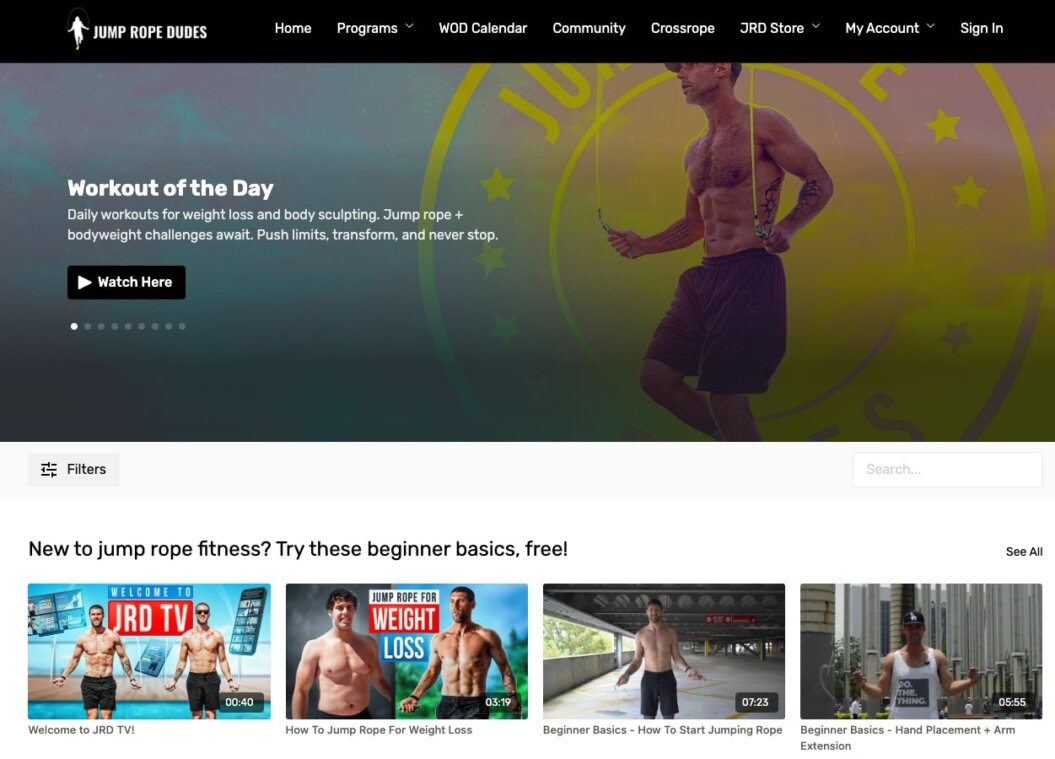
What makes it work? Jump Rope Dudes takes a simple idea—jump rope workouts—and turns it into an engaging fitness experience. Members enjoy vibrant community interaction, accessible workouts, and affordable pricing ($14.99/month or $125.99/year). It’s not just about fitness—it’s about celebrating every success with a supportive community.
Why it’s inspiring: The app combines convenience with inclusivity, featuring offline viewing and interactive challenges that keep members engaged and motivated.
→ Explore more examples of fitness & sports OTT apps here.
Educational OTT App: Art For Kids Hub
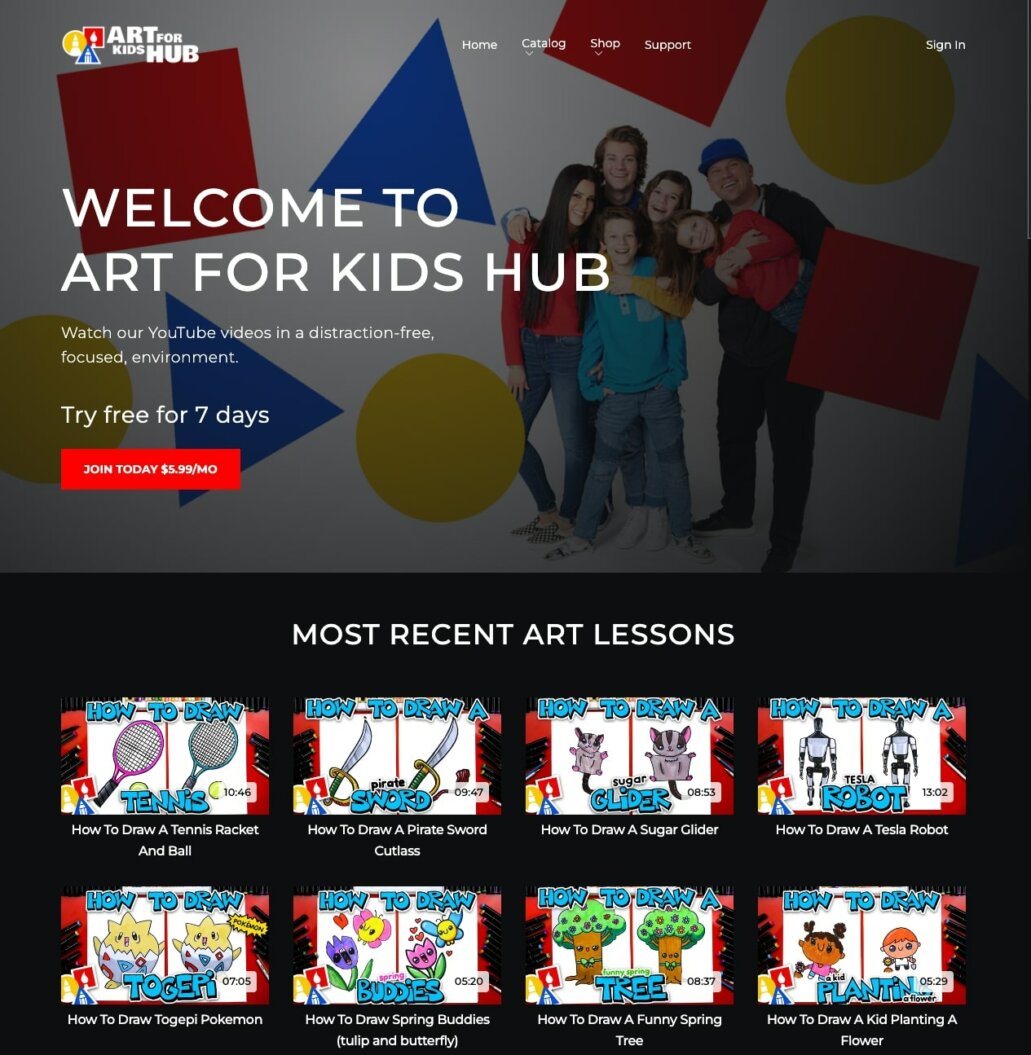
What makes it work? Art For Kids Hub brings creativity to life for families, offering drawing, painting, and origami tutorials. It’s a one-stop art platform that makes learning accessible and fun, with pricing at just $5.99/month or $64.99/year.
Why it’s inspiring: Its affordable plans, family-friendly lessons, and multi-device compatibility make it a favorite for both beginners and seasoned artists.
→ Explore more examples of educational OTT apps here.
Entertainment OTT App: Abundance+
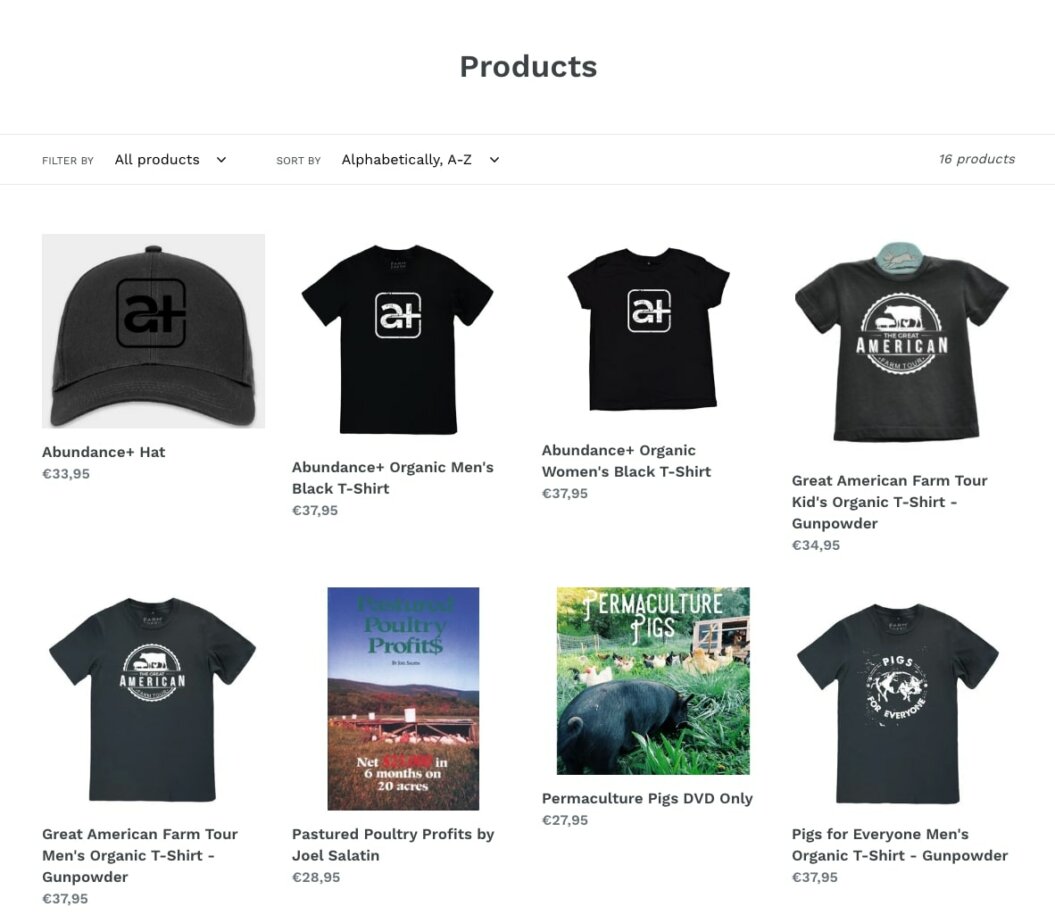
What makes it work? Founded by Justin Rhodes, Abundance+ delivers homesteading and sustainable living content, from masterclasses to documentaries. With a vibrant community and tiered pricing ($6–$29/month), the app creates a meaningful space for enthusiasts.
Why it’s inspiring: Its personal touch, community vibe, and diverse offerings keep members coming back for more.
→ Explore more examples of entertainment OTT apps here
Events OTT App: XR+
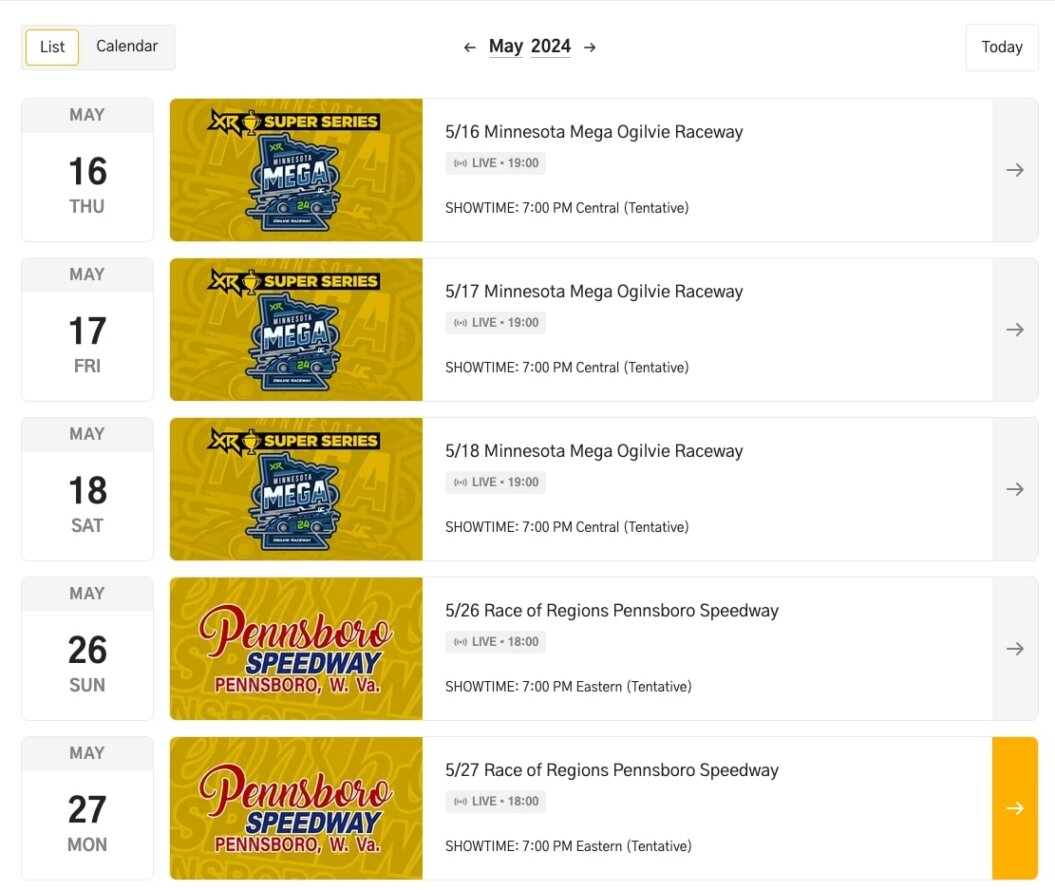
What makes it work? XR+ captures the thrill of dirt track racing, offering live streams and a vast on-demand library. Fans can subscribe for $39.99/month or $199.99/year to enjoy premium-quality racing content.
Why it’s inspiring: XR+ nails engagement by combining live events with on-demand access, ensuring every fan can tune in, on their terms.
→ Explore more examples of OTT apps here
If you’re eager to grow an online course platform that stands out like The Collective, RecipeKick, and Art For Kids Hub, the most important thing to consider is ensuring your platform offers value for money. You can do this via competitive course pricing, trial periods, and rich, interactive content libraries that make users feel their investment is worthwhile.
Focus on delivering specialized and expert-led content, and research how your users want to learn. Do they want quick bite-sized tutorials or in-depth masterclasses in various subjects? Incorporate interactive and supportive features like practical tools and ad-free environments to enhance user engagement and satisfaction.
Launching your OTT apps in the wild!
Listen, I know launching apps might feel like a big leap. But after watching thousands of creators take their content mobile with Uscreen, I can tell you this: the numbers don’t lie.
With 35% more spending on iOS apps and 24% more on Android this year alone, your audience is ready and waiting to engage with your content on their favorite devices.
Here’s what really excites me: every creator who’s taken this step with Uscreen has their own success story.
Whether it’s doubling viewership like In the Lab+, building a million-dollar revenue stream like Abundance+, or creating a thriving fitness community like M/Body – each started exactly where you are now.
Remember these key takeaways:
- Your viewers are already mobile – meet them there
- Apps lead to 15% better retention rates
- You’ll see up to 25% more watch time
- 78% of community engagement happens on mobile
- TV apps open up a whole new audience (just look at that 80% Roku watch time!)
The best part? You don’t have to figure this out alone. At Uscreen, we’ve refined the process, so you can create your OTT platform smoothly. We’ve seen what works, what doesn’t, and most importantly – what makes content creators successful in the long run.
Ready to take your content to the next level? Your audience is waiting. Let’s get your apps out into the wild!
Build, launch and manage your membership, all in one place.




